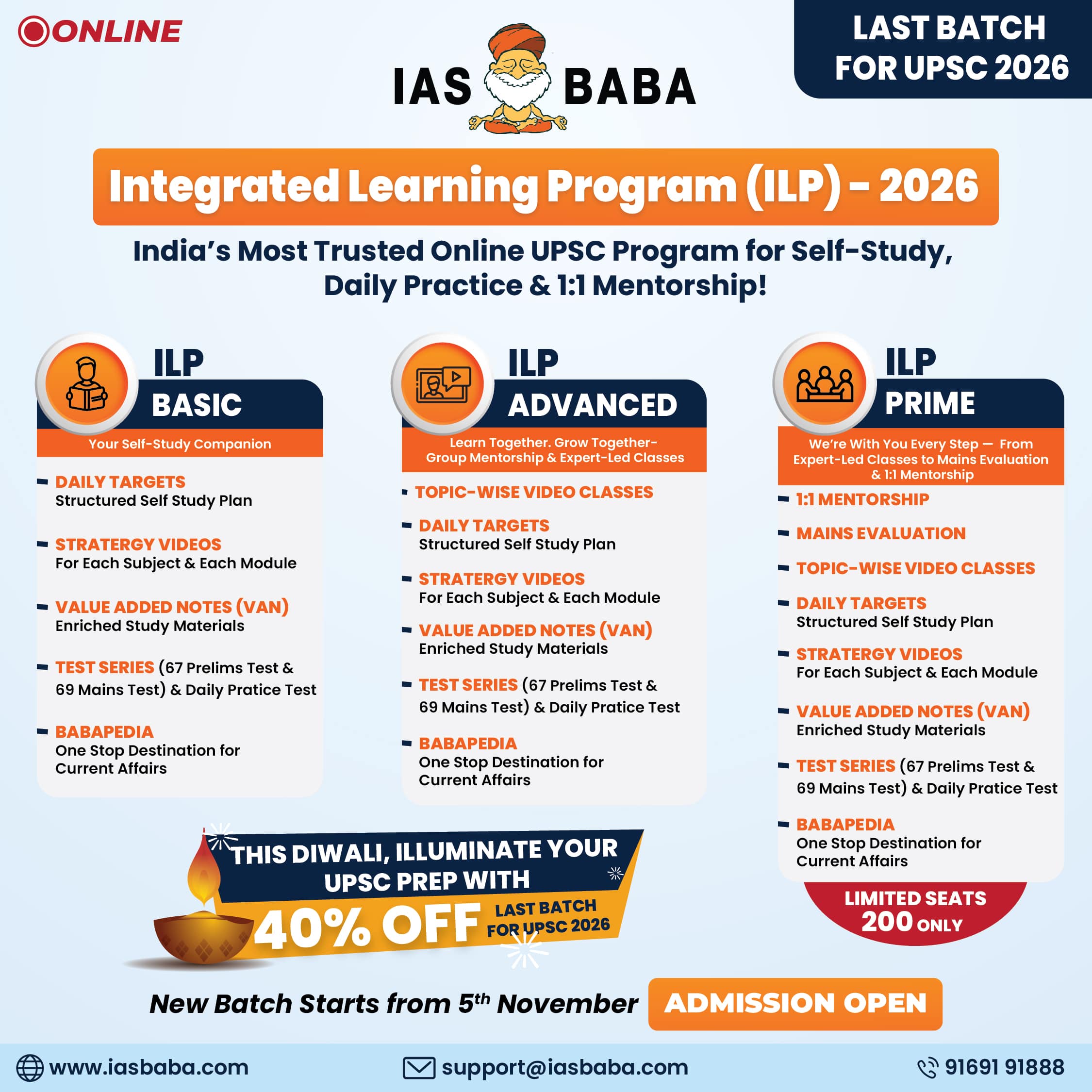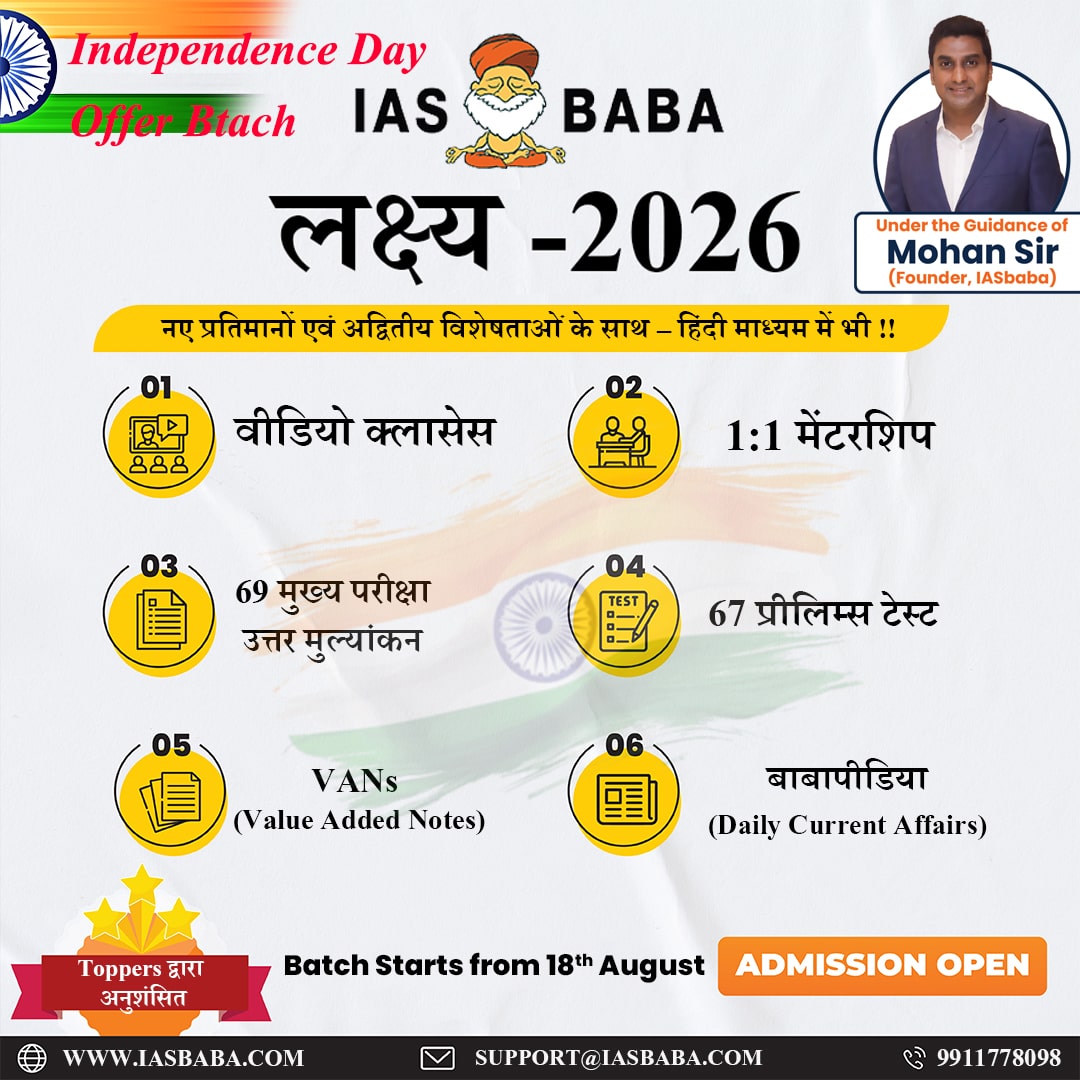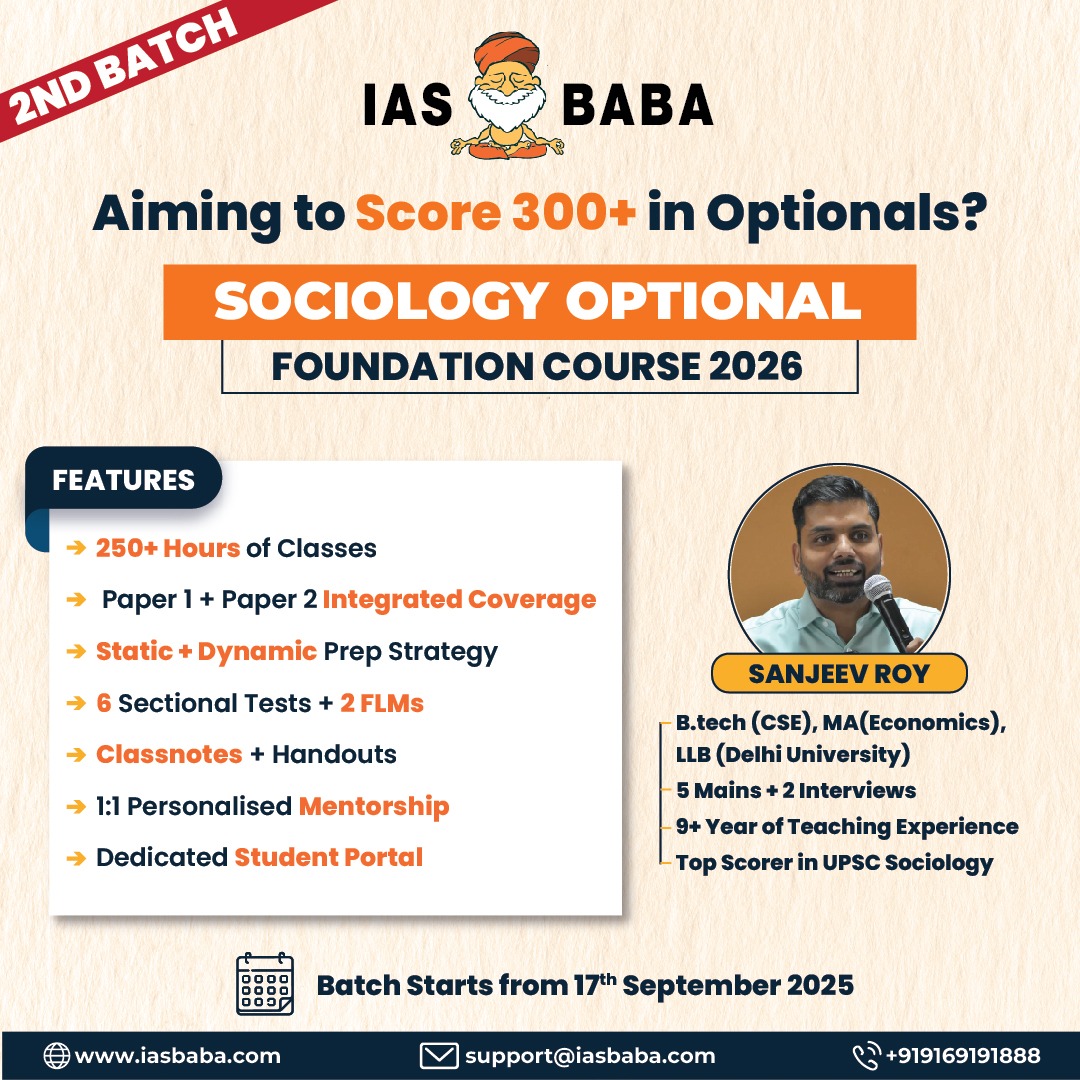IASbaba's Daily Current Affairs Analysis
Archives
(PRELIMS Focus)
Category: INTERNATIONAL
Context: India and the U.S. are in the final stages of talks to conclude a limited trade agreement before the July 8, 2025, deadline.
Key U.S. Demands
- Lower tariffs and non-tariff barriers on American exports—especially autos, medical devices, and agricultural goods (soy, corn, wheat, ethanol, apples).
- Market access for genetically modified (GM) crops.
- Better terms in sectors like aviation and energy.
India’s Stance
- Protects sensitive sectors like agriculture and dairy to safeguard farmers’ interests and food security.
- Offers limited concessions: reduced tariffs on almonds, pistachios, and some defense/energy goods.
- Seeks rollback of U.S. tariffs on Indian steel and auto parts.
Sticking Points
- Disagreement over tariffs on farm goods, steel, and auto components.
- U.S. wants immediate, broad access; India prefers a phased approach.
- Talks may need top-level intervention (Modi-Trump) to break the impasse.
If No Deal by July 8
- A 10% tariff on Indian goods could be reimposed.
- Likely limited impact, as exports have remained resilient.
- India is also strengthening trade ties with the EU and UK.
Learning Corner:
Bilateral Trade Between India and the USA
Overview:
India and the United States share a robust and growing trade relationship, marked by both strategic cooperation and occasional trade tensions. The U.S. is one of India’s largest trading partners, and India is a key market and strategic ally for the U.S. in the Indo-Pacific region.
Key Facts (as of 2024 estimates):
- Total Bilateral Trade: Over $190 billion, making the U.S. India’s largest trading partner.
- India’s Exports to U.S.: ~$118 billion – Includes pharmaceuticals, textiles, IT services, gems & jewelry, auto parts.
- India’s Imports from U.S.: ~$72 billion – Includes crude oil, defense equipment, aircraft, agricultural products, and technology.
Areas of Cooperation:
- Energy Trade: The U.S. is a key supplier of crude oil, LNG, and coal to India.
- Defense & Technology: Growing defense procurement (Apache, C-130, drones), and tech collaboration.
- Services & IT: U.S. is the largest market for India’s IT exports; many Indian professionals work in the U.S. under H-1B visas.
Challenges & Frictions:
- Tariff Disputes: The U.S. often criticizes India’s high tariffs on products like autos and agriculture.
- Trade Barriers: India raises concerns about U.S. visa restrictions and protectionist policies.
- Digital Trade & Data Localization: Emerging areas of disagreement in the tech sector.
Conclusion:
India-U.S. trade is strategic and multifaceted, with significant growth potential. While challenges persist, both countries recognize the mutual economic and geopolitical benefits of a deeper trade partnership.
Different Types of Trade Agreements
Trade agreements are treaties between two or more countries that outline how they will conduct trade with each other. These agreements help reduce trade barriers like tariffs and quotas and promote economic cooperation. The main types include:
Bilateral Trade Agreement (BTA)
- Between: Two countries
- Objective: Reduce tariffs, enhance trade in goods/services, promote investment.
- Example: India–UAE CEPA (Comprehensive Economic Partnership Agreement)
- Features: Tailored to specific mutual interests; faster to negotiate than multilateral agreements.
Multilateral Trade Agreement
- Between: More than two countries, usually under international organizations.
- Example: WTO agreements like GATT, TRIPS
- Objective: Promote global trade by creating uniform rules for all members.
- Features: Broad in scope but difficult to negotiate due to multiple stakeholders.
Free Trade Agreement (FTA)
- Goal: Eliminate tariffs and quotas on most goods traded between member countries.
- Example: India–ASEAN FTA
- Features: Focuses on goods, services, and sometimes investment. Members retain independent trade policies with non-members.
Customs Union
- Goal: Free trade within the union and a common external tariff policy.
- Example: European Union (EU)
- Features: Greater economic integration than FTAs but requires coordination on external trade policies.
Common Market
- Goal: Free movement of goods, services, capital, and labor among member states.
- Example: European Single Market
- Features: Requires deeper political and economic integration; harmonized regulations and laws.
Comprehensive Economic Partnership Agreement (CEPA)
- Goal: Broader than FTAs—covers trade, investment, IPR, dispute resolution, etc.
- Example: India–Japan CEPA
- Features: Includes both tariff and non-tariff issues; often sector-specific cooperation.
Preferential Trade Agreement (PTA)
- Goal: Reduce tariffs on selected goods, not comprehensive.
- Example: India–Mercosur PTA
- Features: Less ambitious than FTAs; serves as a stepping stone toward deeper agreements.
Source: THE HINDU
Category: ENVIRONMENT
Context: Researchers have documented the first camera-trap evidence of the endangered dhole (Cuon alpinus)—also known as the Asiatic wild dog—in the Kaziranga-Karbi Anglong Landscape, Assam
This rediscovery is significant as the species was previously believed to be locally extinct in the region.
The image, captured in the Amguri corridor (a vital wildlife linkage between Kaziranga National Park and Karbi Anglong hills), was taken just 375 metres from a national highway, emphasizing the threat posed by human infrastructure in critical wildlife habitats.
The dhole is classified as Endangered on the IUCN Red List and protected under Schedule I of the Wildlife (Protection) Act, 1972. Its decline across Asia has been due to habitat loss, prey depletion, and human-wildlife conflict.
Kaziranga, a UNESCO World Heritage Site, is already home to species like the one-horned rhinoceros, Bengal tiger, and wild water buffalo. The rediscovery of the dhole enhances the region’s conservation value and highlights the importance of preserving wildlife corridors in Northeast India.
Learning Corner:
Kaziranga National Park
Location:
Kaziranga National Park is located in the state of Assam, India, along the floodplains of the Brahmaputra River.
Key Highlights:
- UNESCO World Heritage Site (since 1985) for its unique natural environment and rich biodiversity.
- Famous for hosting the world’s largest population of the one-horned rhinoceros.
- Also home to the Big Five of Kaziranga:
- One-horned Rhinoceros
- Bengal Tiger
- Asian Elephant
- Wild Water Buffalo
- Swamp Deer
Biodiversity:
- Supports over 35 species of mammals, 500+ bird species, and diverse reptile and plant life.
- Important habitat for migratory birds, river dolphins, and endangered species like the dhole (Asiatic wild dog).
Conservation Status:
- Declared a National Park in 1974.
- Protected under Schedule I of the Wildlife (Protection) Act, 1972.
- Recognized as a Tiger Reserve since 2006.
- Managed by the Assam Forest Department and supported by the National Tiger Conservation Authority (NTCA).
Challenges:
- Seasonal flooding, poaching, habitat fragmentation, and human-wildlife conflict.
- Pressure from nearby highways and settlements affecting wildlife corridors.
Significance:
- A global model for rhino conservation.
- Vital for maintaining ecological balance in the Brahmaputra floodplain.
- Major hub for eco-tourism in Northeast India.
Important Species of Kaziranga National Park
One-Horned Rhinoceros (Rhinoceros unicornis)
- Kaziranga holds the largest population in the world of this species.
- Conservation success story: From a few dozen in the early 1900s to over 2,600 individuals today.
- Listed as Vulnerable on the IUCN Red List.
Bengal Tiger (Panthera tigris tigris)
- Declared a Tiger Reserve in 2006.
- Kaziranga has one of the highest tiger densities in India.
- Protected under Schedule I of the Wildlife Protection Act.
Asian Elephant (Elephas maximus)
- Found in herds across the park, especially during the dry season.
- Listed as Endangered by the IUCN.
Wild Water Buffalo (Bubalus arnee)
- Kaziranga has the largest population of wild water buffalo in India.
- Classified as Endangered on the IUCN Red List.
Swamp Deer (Barasingha) (Rucervus duvaucelii)
- The eastern swamp deer subspecies is unique to this region.
- Lives in marshy grasslands; population under recovery.
Indian Leopard (Panthera pardus fusca)
- Elusive and nocturnal; shares habitat with tigers.
Avifauna (Bird Species)
- Over 500 bird species including migratory birds.
- Notable species:
- Great Indian Hornbill
- Bengal Florican (Critically Endangered)
- Pelicans, Storks, and Raptors
Reptiles and Aquatic Species
- Includes Gharial, Indian Python, Assam Roofed Turtle, and Gangetic Dolphin (in adjoining river systems).
Dhole (Asiatic Wild Dog)
Scientific Name: Cuon alpinus
Common Names: Dhole, Asiatic wild dog, Indian wild dog, Red dog
Conservation Status:
- IUCN Red List: Endangered
- India’s Wildlife Protection Act, 1972: Schedule I
Physical Characteristics:
- Medium-sized canid with a reddish coat, bushy black-tipped tail, and rounded ears.
- Known for their social behavior and cooperative hunting in packs.
Habitat and Distribution:
- Found in forests, grasslands, and mountainous regions across South and Southeast Asia.
- In India, they are found in the Western Ghats, Central India, Northeast India, and parts of the Himalayas.
Ecological Role:
- Apex predator and important for maintaining ecosystem balance by controlling prey populations.
Threats:
- Habitat loss due to deforestation and infrastructure development.
- Decline in prey base, especially in fragmented forests.
- Human-wildlife conflict and disease transmission from domestic dogs.
Source: THE HINDU
Category: POLITY
Context : Constitutional courts in India, particularly the Supreme Court and High Courts, play a vital role in interpreting and enforcing the constitutional principle of equality, especially in the context of gender justice and anti-discrimination.
Key Constitutional Provisions:
- Article 14: Guarantees equality before the law and equal protection of laws.
- Article 15: Prohibits discrimination on specific grounds and allows special provisions for women and children.
- Article 16: Ensures equality of opportunity in public employment.
- Article 39(d): Directs the State to ensure equal pay for equal work for men and women.
Judicial Practice and Landmark Judgments:
Substantive Equality:
Courts have evolved from formal equality to substantive equality, acknowledging the need for affirmative action to overcome structural disadvantages.
Landmark Cases:
- Sabarimala Case (2018): Exclusion of women from the temple ruled unconstitutional.
- P.B. Vijay Kumar (1995): Reservations for women in public jobs upheld under Article 15(3).
- Vishakha Case (1997): Laid down sexual harassment guidelines; linked gender justice to Articles 14, 19, and 21.
- Dharwad PWD Employees Case: Enforced equal pay for equal work.
- Charu Khurana Case: Extended equality principles to private professional bodies.
Principles in Action:
- Affirmative Action: Constitutionally valid; essential for real equality.
- Anti-Discrimination: Laws and practices violating dignity and equality struck down.
- Equal Pay: Courts uphold the right to fair and equal remuneration.
Learning Corner:
Note on Equality
Equality is a fundamental principle of justice that ensures all individuals are treated fairly and without discrimination, irrespective of their caste, gender, religion, race, or social status. It is both a legal right and a moral value essential to democratic societies.
Types of Equality:
- Formal Equality:
- Equal treatment under the law.
- Everyone is subject to the same rules and standards.
- Substantive Equality:
- Focuses on outcomes and real-life access to opportunities.
- Supports affirmative action to correct historical and structural disadvantages.
- Political Equality:
- Equal voting rights and participation in governance.
- Social Equality:
- Elimination of social discrimination based on caste, class, gender, etc.
- Economic Equality:
- Fair distribution of wealth and access to resources.
Equality in the Indian Constitution:
- Article 14: Equality before law and equal protection of laws.
- Article 15: Prohibition of discrimination based on religion, race, caste, sex, or place of birth.
- Article 16: Equality of opportunity in public employment.
- Article 39(d): Equal pay for equal work (Directive Principle).
Importance of Equality:
- Promotes social justice and inclusive development.
- Protects the dignity and rights of individuals.
- Strengthens democracy and rule of law.
- Reduces inequalities and conflicts in society.
Source : THE HINDU
Category: ENVIRONMENT
Context: Green bonds are emerging as a key financial tool for Africa’s climate resilience, enabling investment in renewable energy, infrastructure, and environmental sustainability.
Countries like Nigeria, South Africa, and Morocco have successfully raised green finance for flagship projects, reflecting a growing interest in sustainable finance across the continent.
Why Green Bonds Matter
- Climate Finance Mobilization: Green bonds help fund vital climate mitigation and adaptation projects (e.g., solar, hydropower).
- Private Sector Engagement: Banks and companies now contribute over 60% of green bond issuance value, expanding market participation.
- Support for Climate Goals: They align with Africa’s Paris Agreement commitments, addressing the $146 billion annual climate finance gap.
Key Challenges
- Risk Premium: Investors demand higher returns due to concerns over credit risk, currency volatility, and political instability—raising borrowing costs.
- Structural Barriers: Weak capital markets, poor regulatory frameworks, and lack of standardized green finance norms hinder growth.
- Limited Private Investment: Only 18% of climate finance in Africa comes from private sources, concentrated in a few countries.
- Funding Imbalance: Most funds go to mitigation; only ~7% support adaptation projects, which are harder to finance due to uncertain returns.
Learning Corner:
Bonds and Their Types
What is a Bond?
A bond is a fixed-income financial instrument that represents a loan made by an investor to a borrower (typically a government or corporation). It involves the issuer promising to pay back the principal on a specified maturity date along with periodic interest payments (called coupon payments).
Key Features:
- Issuer: Government, corporation, or financial institution
- Face Value: The amount paid back at maturity
- Coupon Rate: Interest paid to bondholders
- Maturity: Date when the principal is repaid
- Yield: Return based on purchase price and interest
Types of Bonds:
Government Bonds
- Issued by national governments to finance public expenditure.
- In India: G-Secs (Government Securities).
- Usually low risk and offer fixed returns.
Corporate Bonds
- Issued by companies to raise capital for business expansion or operations.
- Higher risk than government bonds but may offer higher returns.
Municipal Bonds
- Issued by local or regional governments to fund infrastructure projects (roads, schools).
- May offer tax benefits to investors.
Green Bonds
- Specifically used to fund environmentally sustainable projects (renewable energy, climate adaptation).
- Aim to combat climate change and support sustainability.
Zero-Coupon Bonds
- Sold at a discount; no periodic interest.
- Investor gets lump sum payment (face value) at maturity.
Inflation-Indexed Bonds
- Returns are adjusted for inflation.
- Protect investors’ real purchasing power.
Convertible Bonds
- Corporate bonds that can be converted into company equity shares under specified conditions.
Sovereign Bonds
- Issued by a country in foreign currency, often targeted at international investors.
Source: THE HINDU
Category: SCIENCE AND TECHNOLOGY
Context: Semaglutide (2.4 mg) has shown exceptional weight loss results, averaging 15–17% body weight reduction over 68 weeks
This far exceeds the outcomes of older weight-loss drugs or lifestyle interventions. Long-term studies confirm weight loss is sustained up to two years.
How It Works
GLP-1 drugs mimic a natural hormone that regulates appetite and food intake. They enhance feelings of fullness, reduce hunger, and help manage blood sugar, making it easier for patients to stick to calorie-restricted diets.
Safety and Tolerability
Generally well-tolerated, these drugs mostly cause mild gastrointestinal symptoms like nausea or diarrhea. Serious side effects are rare, making them suitable for long-term use.
Impact on Health
Beyond weight loss, semaglutide improves cardiometabolic health by lowering blood pressure, improving lipid profiles, and reducing diabetes and cardiovascular disease risks.
Learning Corner:
GLP-1 Receptors
GLP-1 receptors (Glucagon-Like Peptide-1 receptors) are specialized protein receptors found primarily on pancreatic beta cells and also in the brain, heart, stomach, and intestines. They are part of the body’s natural glucose regulation system and play a key role in metabolism and appetite control.
Functions of GLP-1 Receptors:
- Enhance Insulin Secretion:
When blood glucose levels rise, GLP-1 receptors help stimulate insulin release from pancreatic beta cells. - Suppress Glucagon Secretion:
They inhibit glucagon, a hormone that raises blood sugar, helping lower glucose levels after meals. - Slow Gastric Emptying:
GLP-1 receptors reduce the rate at which the stomach empties, promoting satiety and reducing food intake. - Reduce Appetite:
In the brain, activation of these receptors lowers hunger signals, aiding in weight loss.
Therapeutic Importance:
- Drugs that mimic GLP-1 (called GLP-1 receptor agonists, e.g., semaglutide, liraglutide) are widely used in the treatment of:
- Type 2 Diabetes Mellitus – by improving insulin secretion and lowering blood sugar.
- Obesity – by suppressing appetite and promoting sustained weight loss.
Source: THE INDIAN EXPRESS
(MAINS Focus)
Introduction (Context)
NATO Allies met in The Hague, the Netherlands to take decisions that will make NATO an even stronger and fairer Alliance.
What is NATO?
- North Atlantic Treaty Organization is a military alliance of 32 member countries, primarily in Europe and North America.
- NATO’s headquarters is located in Brussels, Belgium.
- NATO promotes democratic values and enables members to consult and cooperate on defence and security-related issues to solve problems, build trust and, in the long run, prevent conflict.
- NATO is committed to the peaceful resolution of disputes. If diplomatic efforts fail, it has the military power to undertake crisis-management operations. These are carried out under the collective defence clause of NATO’s founding treaty – Article 5 of the Washington Treaty or under a United Nations mandate, alone or in cooperation with other countries and international organisations.
Who are NATO’s members today?
Apart from the original 12, members include Greece and Turkey (1952); West Germany (1955; later as Germany); Spain (1982); the Czech Republic, Hungary, and Poland (1999); Bulgaria, Estonia, Latvia, Lithuania, Romania, Slovakia, and Slovenia (2004); Albania and Croatia (2009); Montenegro (2017); North Macedonia (2020); Finland (2023); and Sweden (2024).
Why NATO was formed?
- Following World War II, the Soviet Union’s influence and military presence in Eastern Europe raised concerns among Western nations about potential expansionism. The Czechoslovakia coup (1948) and Berlin Blockade (1948-49) heightened fears of communist spread.
- NATO was formed as a military alliance to deter Soviet aggression and provide a unified defense for its members.
- Hence NATO was formed:
-
- To provide collective security against the Soviet Union.
- To ensure that an attack against one member is considered an attack against all (Article 5).
- To promote political solidarity and military cooperation among Western nations.
NATO’s funding mechanism
NATO’s funding comes from two main sources:
- National (Indirect) Contributions
- These are the largest part of NATO funding.
- Each member country maintains its own forces and capabilities, which can be provided to NATO for its defence activities and operations.
- Direct (Common) Contributions
- Used for activities that benefit all members and cannot be funded by one country alone, such as joint operations, air defence, and command systems.
- Funded based on an agreed cost-sharing formula related to each country’s Gross National Income, reflecting burden-sharing.
Key Components of Common Funding
- Civil Budget – finances NATO Headquarters.
- Military Budget – funds the NATO Command Structure.
- NATO Security Investment Programme – funds military infrastructure and capabilities.
The North Atlantic Council oversees funding, supported by bodies like the Resource Policy and Planning Board, Budget Committee, and Investment Committee, ensuring effective planning and spending.
Relevance of NATO after cold war
- NATO protects members against various external threats, including strategic and ideological challenges posed by China.
- Played a role in stabilising Central and Eastern Europe and promoting stability within the former Soviet bloc.
- Stabilised Western Europe by reducing rivalries among member states, ensuring continued relevance.
Key decisions in NATO Summit 2025
Key decision 1: NATO’s 5% Defence Spending Target
- NATO allies agreed on a 5% GDP defence spending target.
- Breakdown of the 5% Target
- 3.5%: For core defence spending and weapons.
- 1.5%: For defence-related expenditure, including:
- Protecting critical infrastructure
- Cyber defence and networks
- Civil preparedness and resilience
- Defence innovation and industrial base strengthening.
- They’ll now be able to include weapons and ammunition they supply to Ukraine in the equation, making the new target slightly easier to reach, but still difficult for Canada and a number of European countries with economic troubles.
- Progress will be reviewed in 2029, after the next U.S. presidential election.
- Not everyone is on board. Spain officially refused the agreement. Slovakia had reservations. Belgium, France and Italy will struggle to meet the new target.
Key decision 2: Article 5: Collective Defence Clause
- Article 5 states an attack on one member is an attack on all. Members take “such action as deemed necessary, including armed force” to restore security.
- The “One for All, All for One” principle has strengthened NATO’s unity and expanded its membership.
- The leaders reaffirmed their “ironclad commitment” to NATO’s collective defense clause, Article 5.
Key decision 3: Focus Shift Away from Ukraine
- Since 2022, NATO summits supported Ukraine against Russia. Ukrainian President Zelenskyy received assurances of NATO membership being “irreversible” in 2024.
- Policy Changes under Trump
-
- Trump’s administration (2025) reversed US military aid to Ukraine.
- Criticised Zelenskyy as “ungrateful”.
- Ruled out Ukraine’s NATO membership during his second term.
- Outcome at Recent Summit
- Ukraine issue sidelined.
- The declaration mentioned Russia as a “long-term threat to Euro-Atlantic security” without direct condemnation.
Conclusion
NATO has evolved from being a Cold War military alliance focused on deterring the Soviet Union to becoming a broad security organisation addressing diverse threats, including cyber attacks, terrorism, and rising global powers like China. However, challenges such as unequal burden-sharing, geopolitical tensions, and shifting US foreign policy priorities continue to test NATO’s adaptability and relevance in maintaining global and regional stability.
Mains Practice Question
Q “Article 5 is the cornerstone of NATO’s existence.” Analyse its significance in the current geopolitical context. (250 words, 15 marks)
Introduction (Context)
India has refused to sign a joint statement at the Shanghai Cooperation Organisation (SCO) summit in China as it did not reflect the country’s concerns on terrorism. Hence, discussing about SCO and its relevance.
What is SCO?
The Shanghai Cooperation Organisation (SCO) is a regional intergovernmental organisation founded to promote political, economic, and security cooperation across Eurasia. It is often described as a Eurasian political, economic, and security alliance, aiming to build mutual trust, combat terrorism, and enhance connectivity among member states.
Member Nations
The SCO is a grouping of 10 countries, including India, China, Russia, Pakistan, Kazakhstan, Kyrgyzstan, Tajikistan, Uzbekistan, Iran, and Belarus. The roots of the SCO lie in the “Shanghai Five” formed in 1996, consisting of China, Russia, Kazakhstan, Kyrgyzstan and Tajikistan.
Observer States: Afghanistan, Belarus, and Mongolia.
Dialogue Partners: Includes countries like Turkey, Sri Lanka, Nepal, and others seeking closer cooperation with SCO.
Why was SCO formed?
- With the dissolution of the USSR in 1991 into 15 independent countries, there were concerns in the region about extremist religious groups and ethnic tensions coming to the fore. To manage these issues, a grouping was created for cooperation on security matters.
- Key Objectives
- Strengthen mutual trust and neighbourliness.
- Promote regional peace, security, and stability.
- Combat terrorism, extremism, and separatism.
- Enhance economic cooperation, connectivity, and cultural exchanges.
- The SCO is one of the few international organisations with primarily Asian members that deals with security issues. Its Regional Anti-Terrorist Structure (RATS) regularly holds meetings and exchanges information.
Relevance of SCO
- Acts as a counterbalance to Western alliances like NATO in Eurasia.
- Provides a platform for India, China, and Pakistan to engage despite bilateral tensions.
- Enhances regional connectivity projects, e.g. China’s Belt and Road Initiative (BRI) and India’s International North South Transport Corridor (INSTC)
- Conduct Successful “Peace Mission” joint military exercises to enhance anti-terror capabilities.
- Established the Regional Anti-Terrorist Structure (RATS) in Tashkent to coordinate intelligence on extremism.
- Promoted trade facilitation and regional connectivity projects.
- Increased student exchanges, tourism promotion, and cultural festivals strengthening people-to-people ties.
- Launched the SCO Digital Integration Platform to promote fintech and e-commerce linkages.
- Initiated joint disaster management drills in Central Asia in response to increased climate-related disasters.
Recent Summit
- India has refused to sign a joint statement at the Shanghai Cooperation Organisation (SCO) summit in China as it did not reflect the country’s concerns on terrorism.
- In the recent Pahalgam terror attack, victims were shot after they were profiled on religious identity. The Resistance Front, a proxy of UN-designated terror group Lashkar-e-Taiba (LeT) claimed responsibility for the attack. India follow zero tolerance policy on terrorism.
- When the SCO draft statement did not mention Pahalgam but talked about the train hijacking in Balochistan, India has refuled to sign the statement.
Significance
Traditionally, Russia and China have dominated the SCO. With Russia’s focus diverted due to the Ukraine war since 2022, China’s influence has increased, especially as the 2025 SCO chair.
Further, Pakistan remains a key ally of China. Beijing has provided military aid to Pakistan, particularly after Operation Sindoor. China also uses its global clout to shield Pakistan from adverse international resolutions.
In this context, India’s refusal to sign the SCO draft document gains significance. No joint statement was issued at this year’s SCO meeting because India did not agree.
India reiterated its stance of ‘no compromise on terrorism’, highlighting that business as usual is not possible with nations supporting terrorism.
Challenges faced by SCO
- India-Pakistan and India-China tensions limit consensus building, as seen in the stalled SCO connectivity masterplan in 2025.
- Russia-China growing dominance raises concerns among smaller Central Asian states about sovereignty and equal say.
- Despite frameworks, intra-SCO trade remains low due to lack of infrastructure harmonisation and tariff barriers.
- Continued security threats, narcotics trafficking, and refugee influx remain unresolved despite SCO’s outreach efforts.
- Duplication of objectives with organisations like CSTO, EAEU, and BRICS dilutes focus and resources.
- Member states’ differing alignments with the US, EU, and other blocs hinder deeper strategic cohesion.
Conclusion
The SCO remains a crucial regional platform for fostering security and economic cooperation in Eurasia. However, its effectiveness is constrained by internal rivalries, unequal capacities, and geopolitical complexities. Going forward, its ability to address new age challenges such as digital governance, climate resilience, and inclusive connectivity will determine its relevance in shaping Eurasia’s strategic future.
Mains Practice Question
Q “Despite its growing membership and agenda, SCO’s effectiveness remains limited.” Do you agree? Substantiate with examples. (250 words, 15 marks)
Daily Practice MCQs
Today’s – Daily Practice MCQs’ will be updated in our “Daily Current Affairs Quiz” section on our website
Please click on the below link













